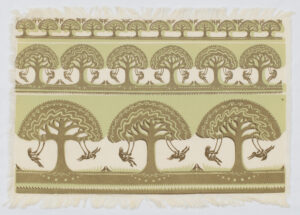In an extract from the introduction to ‘Trailblazing Women Printmakers: Virginia Lee Burton Demetrios and the Folly Cove Designers’, recently published by Chronicle Books, Elena M. Sarni looks at the inception of the block-printing collective, and the local flora and fauna that inspired their designs.

Libby Holloran, ‘Sugar Bush’. Photograph by Gary Lowell, courtesy of Susana McDonnell and Angus Smith
A simple Yankee swap in 1938 between neighbors in the quaint neighborhood of Folly Cove, in Gloucester, Massachusetts—design lessons in exchange for music instruction—became the foundation of the Folly Cove Designers, one of the longest running and most successful juried artist guilds in American history. Renowned children’s book author and illustrator Virginia Lee Burton (of Mike Mulligan and His Steam Shovel fame) traded design lessons in exchange for violin lessons for her sons, leading to community-wide design classes and, ultimately, the formation of the famed eponymous block-printing collective, which operated from 1941 through 1969. The group produced over three hundred distinct designs conveying personal and regional narratives through the use of shared design principles taught to them by Virginia.


Peggy Norton, ‘Apple Pie’ (top), photograph by Peter Morse, courtesy of Anne Morin, and ‘Deciduous’ (bottom), photograph by Eric Roth, courtesy of Faith Ronan
Within the first ten years of organizing, the Folly Cove Designers were propelled to international fame through commercial contracts with major retailers (Lord & Taylor and F. Schumacher & Co.) and articles about the group in national periodicals such as Life. Despite this success (and their connection with some of the most powerful people in the fields of craft and design during World War II and the postwar period), over time the story of the Folly Cove Designers has in large part receded into the annals of local history.

Louise Kenyon, ‘Garland of the States’. Photograph by Peter Morse, Courtesy of Ann and Sue Kenyon
The inspiration for the Folly Cove designs originated from the flora and fauna of Cape Ann. After a rail line connecting Boston and Gloucester was built in the middle of the 1800s, Gloucester emerged as an artist destination. Folly Cove in particular, located on Gloucester’s north shore, with its rugged beauty, has inspired generations of artists. By the late 1930s, Folly Cove was an established artist community.
Abstract Expressionism, an emotive, spontaneous form of art, evolved during World War II and cemented New York City as a center for international art. In contrast, the Folly Cove Designers were trained to draw subjects from life and as realistically as possible. One of the other primary differences between the Folly Cove Designers and other printmaking groups at the time was that they were a juried group. Most of the members were not full-time artists, but working another job and/or taking care of a family. The goal of the Folly Cove Designers was purely to produce “good design.” While there are some similarities between the Folly Cove Designers and other printmaking groups, they are generally unlike any of their contemporaries in style or subject matter. This individuality was part of their appeal.

Elizabeth Iarrobino, ‘Sandpipers’. Photograph by Peter Morse, courtesy of the Iarrobino family
Virginia made it clear from the start that you didn’t have to be an artist to join the group—you just had to be willing to do the work. That meant months of “homework”, culminating in the submission of a design to the Folly Cove jury; approval brought membership to the Folly Cove Designers.
Many of the women in the group were college-educated, professional, working mothers at a time when research indicates that most women spent fifty hours a week on housework. Like other women, they did set the table for their families every night, only they did so while wearing aprons that they had personally designed, carved into linoleum blocks, printed, and sewn themselves.
This book examines the community, personal lives, and work of the Folly Cove Designers in an attempt to understand how the designs of this local art movement ended up having such tremendous national appeal, transcending the rolling fields and ocean views of Folly Cove to find favor on New York’s Fifth Avenue and beyond.

Virginia Lee Burton Demetrios, ‘Swing Tree’. Photograph by Gary Lowell, courtesy of Sandy Bay Historical Society
*
‘Trailblazing Women Printmakers: Virginia Lee Burton Demetrios and the Folly Cove Designers’ is out now and available here (£24.70).